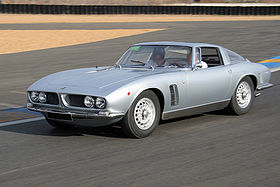Iso Grifo
| Iso Grifo | |
|---|---|
 |
|
| Overview | |
| Manufacturer | Iso Autoveicoli S.p.A. |
| Production | 1963-1974 |
| Designer | Giorgetto Giugiaro at Bertone |
| Body and chassis | |
| Body style | 2-door coupe |
| Layout | FR layout |
| Powertrain | |
| Engine | American 5.4 l OHV-V8 (Chevrolet 327), 300/355 hp 5.8 l OHV-V8 (Ford 351 Cleveland), 365 hp (270 kW) 7.0 l OHV-V8 (Chevrolet 427), 435 hp (320 kW) 7.4 l OHV-V8 (Chevrolet 454), 395 hp (295 kW) |
| Transmission | 4-speed Muncie or 5-speed ZF manual transmission 3-speed automatic (on request) |
| Dimensions | |
| Wheelbase | 98.4 in (2,499 mm) |
| Length | 174.4 in (4,430 mm) |
| Width | 69.7 in (1,770 mm) |
| Height | 47.2 in (1,199 mm) |
| Curb weight | 3,150–3,550 lb (1,430–1,610 kg) |
The Iso Grifo is a limited production grand tourer automobile manufactured by Italian Iso Autoveicoli S.p.A. between 1965 and 1974. Intended to compete with Ferrari and Maserati GTs, it utilized a series of American power trains and components supplied by Chevrolet and Ford to ensure performance and maximize reliability. Styling was done by Giorgetto Giugiaro at Bertone, while the mechanicals were the work of Giotto Bizzarrini.
The first production GL models appeared in 1965 and were powered by American Chevrolet Corvette small-block 327 (5.4 l) V8s fitted to American supplied Borg-Warner 4-speed manual transmissions. With over 400 horsepower (300 kW) and a vehicle weight of less than 2,200 pounds (1,000 kg), the Grifo was able to reach speeds over 275 km/h (171 mph).
In 1970 the Grifo Series II appeared, with sleeker styling and hide-away headlights and motivated by big-block Chevrolet 454 V8 (7.5 l)power. It was replaced in 1972 with the Grifo IR-8, which utilized a small-block Ford Boss 351 engine (5.8 l) as its power train. This was the last Iso of any type, as the manufacturer went bankrupt and eventually shut down and ceased all operations permanently in 1974.
Iso in Bresso was already well known for producing the high performance Iso Rivolta IR 300; a sleek looking 2+2 Coupe based on a Chevrolet Corvette power and drive train. After leaving Ferrari, in 1961 Giotto Bizzarrini set up “Prototipi Bizzarrini” in Livorno, Tuscany where he designed and consulted for marques like ATS, Lamborghini and Iso. In 1963, he designed the Iso Grifo A3/L (L for Lusso {Italian for Luxury}) for Renzo Rivolta, who was looking for a follow-up to his Iso Rivolta IR 300. The body was designed by Giorgetto Giugiaro at Bertone, while Bizzarrini put his expertise in the mechanicals. Bizzarrini figured there would also be a demand for a race version of the Grifo and came up with the A3/C (C for Corsa) with a dramatic modified alloy body. He later dubbed it his “Improved GTO", as he had been the designer for the 250 GTO when he had worked for Ferrari. The engine was moved back about 4 decimetres (16 in), making the A3/C a front-mid-engined car. To adjust the timing a piece of the dash was removed. Both cars were being built simultaneously. When leaving the factory both the 250 GTO and Iso Grifo originally fitted Pirelli Cinturato 205VR15 tires (CN72).
...
Wikipedia
